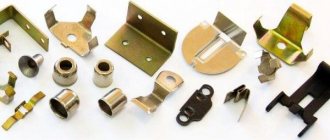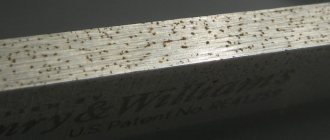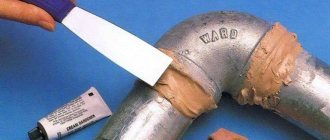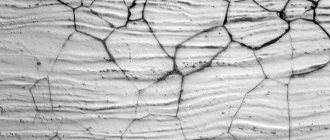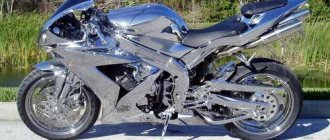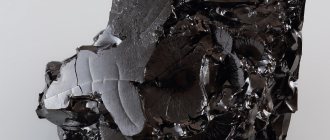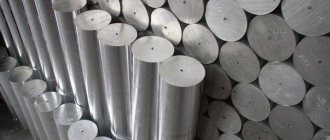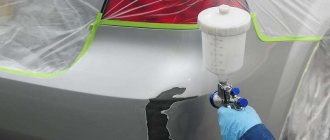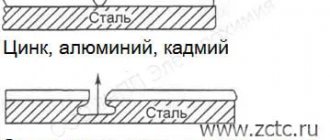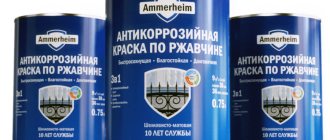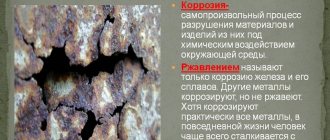Rust color
Rust
- is a general term for iron oxides.
Colloquially, the word applies to the red oxides formed by the reaction of iron with oxygen in the presence of water or moist air. There are other forms of rust, such as a product formed when iron reacts with chlorine in the absence of oxygen. This substance is formed, in particular, in the reinforcement used in underwater concrete pillars, and is called green rust
. Several types of corrosion are distinguishable visually or using spectroscopy, and they form under different environmental conditions. Rust consists of hydrated iron (III) oxide Fe2O3 nH2O and iron metahydroxide (FeO(OH), Fe(OH)3). Given oxygen, water and enough time, any mass of iron will eventually convert completely to rust and break down. A rust surface does not provide protection for the underlying iron, unlike the formation of a patina on a copper surface.
Rust generally refers to the corrosion product of iron and its alloys such as steel. Many other metals also corrode, but it is iron oxides that are commonly referred to as rust.
Chemical reactions
A thick layer of rust on chain links near the Golden Gate Bridge in San Francisco. The chain is constantly exposed to dampness and salty splashes, causing surface destruction, cracking and peeling of the metal.
Causes of rusting
If iron, which contains any additives or impurities (such as carbon), is in contact with water, oxygen or other strong oxidizing agent and/or acid, it will begin to rust. If salt is present, for example, there is contact with salt water, corrosion occurs faster as a result of electrochemical reactions. Pure iron is relatively resistant to the effects of pure water and dry oxygen. As with other metals, such as aluminum, a tightly adhered oxide coating on the iron (passivation layer) protects the bulk of the iron from further oxidation. The transformation of the passivating layer of iron oxide into rust is the result of the combined action of two reagents, usually oxygen and water. Other destructive factors are sulfur dioxide and carbon dioxide in water. Under these aggressive conditions, various types of iron hydroxide are formed. Unlike iron oxides, hydroxides do not protect the bulk of the metal. As hydroxide forms and flakes off the surface, the next layer of iron is exposed and the corrosion process continues until all the iron is destroyed or the system runs out of all oxygen, water, carbon dioxide or sulfur dioxide.
Reactions that take place
A bolt covered in rust and dirt.
Pitting corrosion and gradual surface deformation caused by severe oxidation are noticeable. Rusting of iron is an electrochemical process that begins with the transfer of electrons from iron to oxygen. The rate of corrosion depends on the amount of water available, and is accelerated by electrolytes, as evidenced by the effects of road salt on vehicle corrosion. The key reaction is oxygen reduction:
O2 + 4 e− + 2 H2O → 4 OH−
Since this produces hydroxide anions, the process is highly dependent on the presence of acid. Indeed, corrosion of most metals by oxygen is accelerated by lower pH. The supply of electrons for the above reaction occurs through the oxidation of iron, which can be described as follows:
Fe → Fe2+ + 2 e−
The following redox reaction occurs in the presence of water and is critical for rust formation:
4 Fe2+ + O2 → 4 Fe3+ + 2 O2−
In addition, the following multi-stage acid-base reactions affect the course of rust formation:
Fe2+ + 2 H2O ⇌ Fe(OH)2 + 2 H+ Fe3+ + 3 H2O ⇌ Fe(OH)3 + 3 H+
which leads to the following reactions maintaining the dehydration balance:
Fe(OH)2 ⇌ FeO + H2O Fe(OH)3 ⇌ FeO(OH) + H2O 2 FeO(OH) ⇌ Fe2O3 + H2O
From the above equations it is clear that the formation of corrosion products is due to the presence of water and oxygen. With the limitation of dissolved oxygen, iron (II)-containing materials, including FeO and black magnet (Fe3O4), come to the fore. High oxygen concentrations are favorable for ferric iron materials, with the nominal formula Fe(OH)3-xOx/2. The nature of corrosion changes over time, reflecting the slow reaction rates of solids.
In addition, these complex processes depend on the presence of other ions such as Ca2+, which serve as an electrolyte and thus accelerate the formation of rust, or in combination with iron hydroxides and oxides to form various precipitates of the form Ca-Fe-O-OH.
Moreover, the color of rust can be used to check for the presence of Fe2+ ions, which change the color of rust from yellow to blue.
Gas corrosion
The most common type of chemical corrosion, gas corrosion, is a corrosion process that occurs in gases at elevated temperatures. This problem is typical for the operation of many types of technological equipment and parts (furnace fittings, engines, turbines, etc.). In addition, ultra-high temperatures are used when processing metals under high pressure (heating before rolling, stamping, forging, thermal processes, etc.).
The peculiarities of the state of metals at elevated temperatures are determined by two of their properties - heat resistance and heat resistance. Heat resistance is the degree of stability of the mechanical properties of a metal at ultra-high temperatures. Stability of mechanical properties refers to maintaining strength over a long period of time and resistance to creep. Heat resistance is the resistance of a metal to the corrosive activity of gases at elevated temperatures.
The rate of development of gas corrosion is determined by a number of indicators, including:
- atmospheric temperature;
- components included in a metal or alloy;
- parameters of the environment where gases are located;
- duration of contact with the gas environment;
- properties of corrosive products.
The corrosion process is more influenced by the properties and parameters of the oxide film that appears on the metal surface. Oxide formation can be chronologically divided into two stages:
- adsorption of oxygen molecules on a metal surface interacting with the atmosphere;
- contact of a metal surface with a gas, resulting in a chemical compound.
The first stage is characterized by the appearance of an ionic bond, as a consequence of the interaction of oxygen and surface atoms, when the oxygen atom takes a pair of electrons from the metal. The resulting bond is exceptionally strong - it is greater than the bond of oxygen with the metal in the oxide.
The explanation for this connection lies in the action of the atomic field on oxygen. As soon as the metal surface is filled with an oxidizing agent (and this happens very quickly), at low temperatures, thanks to the van der Waals force, the adsorption of oxidizing molecules begins. The result of the reaction is the appearance of a thin monomolecular film, which becomes thicker over time, complicating the access of oxygen.
At the second stage, a chemical reaction occurs, during which the oxidizing element of the medium takes valence electrons from the metal. Chemical corrosion is the end result of a reaction.
Characteristics of the oxide film
The classification of oxide films includes three types:
- thin (invisible without special devices);
- medium (tarnished colors);
- thick (visible to the naked eye).
The resulting oxide film has protective capabilities - it slows down or even completely inhibits the development of chemical corrosion. Also, the presence of an oxide film increases the heat resistance of the metal.
However, a truly effective film must meet a number of characteristics:
- be non-porous;
- have a continuous structure;
- have good adhesive properties;
- differ in chemical inertness in relation to the atmosphere;
- be hard and resistant to wear.
One of the above conditions, a continuous structure, is especially important. The continuity condition is the excess of the volume of the oxide film molecules over the volume of the metal atoms. Continuity is the ability of the oxide to cover the entire metal surface with a continuous layer. If this condition is not met, the film cannot be considered protective. However, there are exceptions to this rule: for some metals, for example, magnesium and alkaline earth elements (except beryllium), continuity is not a critical indicator.
Several techniques are used to determine the thickness of the oxide film. The protective qualities of the film can be determined at the time of its formation. To do this, the rate of metal oxidation and the parameters of the rate change over time are studied.
For already formed oxide, another method is used, which consists of studying the thickness and protective characteristics of the film. To do this, a reagent is applied to the surface. Next, experts record the time it takes for the reagent to penetrate, and based on the data obtained, they draw a conclusion about the thickness of the film.
Note! Even the fully formed oxide film continues to interact with the oxidizing environment and the metal.
Rate of corrosion development
The intensity with which chemical corrosion develops depends on the temperature regime. At high temperatures, oxidative processes develop more rapidly. Moreover, reducing the role of the thermodynamic factor in the reaction does not affect the process.
Cooling and variable heating are of considerable importance. Due to thermal stress, cracks appear in the oxide film. Through the holes, the oxidizing element reaches the surface. As a result, a new layer of oxide film is formed, and the old one peels off.
The components of the gaseous environment also play an important role. This factor is individual for different types of metals and is consistent with temperature fluctuations. For example, copper corrodes quickly if it comes into contact with oxygen, but is resistant to this process in a sulfur oxide environment. For nickel, on the contrary, sulfur oxide is destructive, and stability is observed in oxygen, carbon dioxide and an aqueous environment. But chromium is resistant to all of the above environments.
Note! If the level of oxide dissociation pressure exceeds the pressure of the oxidizing element, the oxidation process stops and the metal acquires thermodynamic stability.
The rate of the oxidation reaction is also affected by the components of the alloy. For example, manganese, sulfur, nickel and phosphorus do not contribute in any way to the oxidation of iron. But aluminum, silicon and chromium make the process slower. Cobalt, copper, beryllium and titanium slow down the oxidation of iron even more. Additions of vanadium, tungsten and molybdenum will help make the process more intense, which is explained by the fusibility and volatility of these metals. Oxidation reactions occur most slowly with an austenitic structure, since it is most adapted to high temperatures.
Another factor on which the corrosion rate depends is the characteristics of the treated surface. A smooth surface oxidizes more slowly, and an uneven surface oxidizes faster.
Rust Prevention
Peeling paint exposes areas of rusty sheet metal surface.
Rust is permeable to air and water, so the underlying iron continues to corrode. Preventing rust therefore requires a coating that prevents rust from forming. A passivating layer of chromium (III) oxide forms on the surface of stainless steel. A similar manifestation of passivation occurs with magnesium, titanium, zinc, zinc oxide, aluminum, polyaniline and other electrically conductive polymers.
Galvanization
A good approach to preventing rust is the galvanization method, which typically involves applying a layer of zinc to the object to be protected, either by hot-dip galvanizing or electroplating. Zinc is traditionally used because it is inexpensive, has good adhesion to steel, and provides cathodic protection to the steel surface if the zinc layer is damaged. In more aggressive environments (such as salt water), cadmium is preferred. Galvanization often does not reach the seams, holes and joints through which the coating was applied. In these cases, the coating provides cathodic protection to the metal, where it acts as a galvanic anode, which is primarily affected by corrosion. Aluminum is added to more modern coatings; the new material is called zinc-aluminum
. The aluminum in the coating migrates, covering scratches and thus providing longer lasting protection. This method relies on the use of aluminum and zinc oxides to protect surface scratches, as opposed to an oxidation process such as a galvanic anode. In some cases, in very aggressive environments or long service life, both zinc galvanization and other protective coatings are used simultaneously to provide reliable protection against corrosion.
Cathodic protection
Cathodic protection is a method used to prevent corrosion in structures hidden underground or underwater by introducing an electrical charge that inhibits electrochemical reactions. If used correctly, corrosion can be stopped completely. In its simplest form, this is achieved by connecting the object to be protected to a sacrificial anode, resulting in only a cathodic process occurring on the surface of the iron or steel. The sacrificial anode must be made of a metal with a more negative electrode potential than iron or steel, usually zinc, aluminum or magnesium.
Paintwork and other protective coatings
Rust can be prevented by using paint and other protective coatings that isolate the iron from the environment. Large surfaces divided into sections, such as the hulls of ships and modern cars, are often coated with wax-based products. Such treatments also contain corrosion inhibitors. Coating steel reinforcement with concrete (reinforced concrete) provides some protection for steel in high pH environments. However, corrosion of steel in concrete is still a problem.
Metal coating
Rust can completely destroy iron. Pay attention to the galvanization of non-rusted areas.
- Galvanizing (Galvanized Iron/Steel): Iron or steel is coated with a layer of zinc. The hot-dip galvanizing method or the zinc blowing method can be used.
- Tinning: Mild steel sheet is coated with a layer of tin. Currently, it is practically not used due to the high cost of tin.
- Chrome Plating: A thin layer of chrome is electrolytically applied to steel, providing both corrosion protection and a bright, polished appearance. Often used in shiny components of bicycles, motorcycles and automobiles.
Blueing
Blueing is a method that can provide limited corrosion resistance to small steel objects, such as firearms, etc. The method consists of obtaining a layer of iron oxides 1-10 microns thick on the surface of carbon or low-alloy steel or cast iron. To add shine, as well as to improve the protective properties of the oxide film, it is impregnated with mineral or vegetable oil.
Humidity reduction
Rust can be avoided by reducing the humidity in the air surrounding the iron. This can be achieved, for example, using silica gel.
Inhibitors
Corrosion inhibitors, such as gaseous or volatile inhibitors, can be used to prevent corrosion in closed systems. Some corrosion inhibitors are extremely toxic. One of the best inhibitors are salts of technicic acid.
Rust removers
Today it is not uncommon to find special paint for rust. It is represented on the domestic market by a large number of brands. Its advantage is that it gives a fairly dense coating. It has a triple effect.
It combines the functions:
- rust converter,
- primers,
- coloring matter with a high level of density.
It not only removes traces of rust, but also makes the coating smoother and more attractive. Paints for working with rusty objects have a high level of color saturation, so that even in one layer all traces of rusty deposits are hidden. In this case, a small layer of film is formed on the metal, which prevents rust from spreading further and developing a new one.
Economic effect
Rust causes degradation of products and structures made from iron-based materials. Since rust has a much larger volume than the original iron, its buildup leads to rapid destruction of the structure, increasing corrosion in adjacent areas - a phenomenon called rust eating
. This phenomenon caused the destruction of the Mianus River Bridge (Connecticut, USA) in 1983, when the bearings of the lifting mechanism completely rusted from the inside. As a result, this mechanism caught the corner of one of the road slabs and moved it from the supports. Rust was also a major cause of the collapse of the Silver Bridge in West Virginia in 1967, when the steel suspension bridge collapsed in less than a minute. 46 drivers and passengers who were on the bridge at the time were killed.
Kinzu Bridge after destruction.
The Kinzu Bridge in Pennsylvania was torn down by a tornado in 2003, in large part because the central support bolts connecting the structure to the ground had rusted, leaving the bridge supported only by gravity.
In addition, corrosion of concrete-coated steel and iron can cause the concrete to split, creating serious design difficulties. This is one of the most common failures of reinforced concrete bridges.
